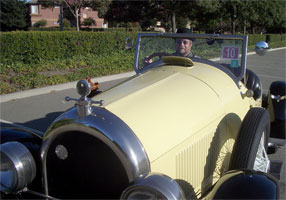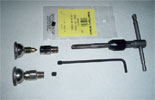
The Serious Freshening
Go to <Last, Summary, Next>Engine—Compression Test
 Lynn in Bugsby, September 5, 2005 |
Completed: 2006-07-20 — Started: 2006-07-15
 |
 |
| COMPRESSION TEST: Results of new compression tests (left) shows dramatic improvement over earlier tests. The readings are taken with a 1920's Hastings compression gauge (right) that Lynn bought on ebay. |
Work Completed:
The earlier compression test that Lynn
performed during his initial freshening indicated that there was a serious problem with
Bugsby's engine, probably in the valves.
Those tests revealed that cylinder #4 had very low pressure, more than 30 PSI lower than the
maximum reading of the other cylinders.
The results of new compression tests are shown in the table above. The first tests performed on July 15 show that the valve job has corrected the low pressure in cylinder #4, boosting it from about 36 PSI to 72 PSI, a factor of two increase! The valve job has also considerably raised the compression in other cylinders. Now the maximum compression of 76 PSI is close to the 80 PSI that is predicted for a 4.6:1 compression ratio.
There is also an acceptably low variation in readings between cylinders. Three of the cylinders are reading at the maximum observed pressure of 76 PSI. Even the lowest reading cylinder only differs from the maximum reading by about 6 PSI.
 |
 |
| PLUGGING PRIMER CUPS: To assure that the primer cups aren't leaking, Lynn installs plugs (left). Lynn creates threads in the base using a 1/4"-20 tap (right). |
Lynn suspects that some of the remaining variation between cylinders might be explained by leaking primer cups as he thinks he can hear one or more of them leaking when the engine is cranking. As he has never found a need to use the primer cups (he might change his mind if he lived in a colder climate or used 1920s quality fuels), Lynn decides to actively plug the primer cups. However, Lynn wants to install a plug that can be easily removed without permanent damage, and that can be easily discovered and reversed by a future owner of Bugsby. Lynn uses a tap to thread the base of the primer cup adapter and installs a 1/4"-20x1/4" hex-socket set screw to positively plug each primer cup. This modification is completely invisible once the primer cups are reinstalled in the engine, but Lynn feels fairly certain he won't have to worry about leaking primer cups anymore.
While thinking more about his compression testing, Lynn remembers a note in the Bill Cannon article (reference at bottom of compression test table, above) that compression tests should be run with a wide open throttle. Lynn performs additional compression tests on July 16 with plugged primer cups and a wide open throttle. He's pleased to see that the readings in most cylinders are 4-6 PSI higher, and agree very well with the maximum predicted pressure.
The one exception is cylinder #3, whose pressure actually decrease slightly from the second to third set of tests. Cylinder #3 is only about 8 PSI below the average of the other cylinders and within an acceptable operating range, but Lynn isn't totally satisfied with the current results. He intends to swap primer cups between cylinders #3 and 1 to see if the low pressure reading moves in a subsequent test.
Work Remaining:
None.
Contact
 with your comments or questions
with your comments or questionsCopyright © 2018 Lynn Kissel
Last updated: May 24, 2009